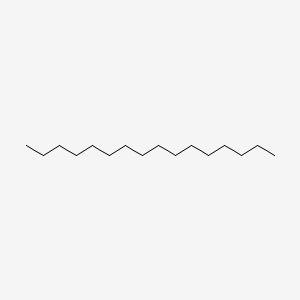| MeSH term | MeSH ID | Detail |
|---|---|---|
| Lupus Erythematosus, Systemic | D008180 | 43 associated lipids |
| Body Weight | D001835 | 333 associated lipids |
| Coronary Disease | D003327 | 70 associated lipids |
| Peritonitis | D010538 | 38 associated lipids |
| Hyperplasia | D006965 | 34 associated lipids |
| Glomerulonephritis | D005921 | 35 associated lipids |
| Encephalomyelitis, Autoimmune, Experimental | D004681 | 26 associated lipids |
| Keratosis | D007642 | 9 associated lipids |
| Serratia Infections | D016868 | 2 associated lipids |
Hexadecane
Hexadecane is a lipid of Fatty Acyls (FA) class. The involved functions are known as Analyte. The related lipids are Fatty Acids and palmitoleic acid.
Cross Reference
Introduction
To understand associated biological information of Hexadecane, we collected biological information of abnormalities, associated pathways, cellular/molecular locations, biological functions, related genes/proteins, lipids and common seen animal/experimental models with organized paragraphs from literatures.
What diseases are associated with Hexadecane?
There are no associated biomedical information in the current reference collection.
Possible diseases from mapped MeSH terms on references
We collected disease MeSH terms mapped to the references associated with Hexadecane
PubChem Associated disorders and diseases
What pathways are associated with Hexadecane
There are no associated biomedical information in the current reference collection.
PubChem Biomolecular Interactions and Pathways
Link to PubChem Biomolecular Interactions and PathwaysWhat cellular locations are associated with Hexadecane?
There are no associated biomedical information in the current reference collection.
What functions are associated with Hexadecane?
Related references are published most in these journals:
| Function | Cross reference | Weighted score | Related literatures |
|---|
What lipids are associated with Hexadecane?
Related references are published most in these journals:
| Lipid concept | Cross reference | Weighted score | Related literatures |
|---|
What genes are associated with Hexadecane?
There are no associated biomedical information in the current reference collection.
What common seen animal models are associated with Hexadecane?
There are no associated biomedical information in the current reference collection.
NCBI Entrez Crosslinks
All references with Hexadecane
Download all related citations| Authors | Title | Published | Journal | PubMed Link |
|---|---|---|---|---|
| Lai ZW et al. | Biosynthesis of high molecular weight hyaluronic acid by Streptococcus zooepidemicus using oxygen vector and optimum impeller tip speed. | 2012 | J. Biosci. Bioeng. | pmid:22608992 |
| Ostroumova OS et al. | Probing amphotericin B single channel activity by membrane dipole modifiers. | 2012 | PLoS ONE | pmid:22276169 |
| Zhou L and Elias RJ | Factors influencing the antioxidant and pro-oxidant activity of polyphenols in oil-in-water emulsions. | 2012 | J. Agric. Food Chem. | pmid:22356204 |
| Kornhauser A et al. | Effects of cosmetic formulations containing hydroxyacids on sun-exposed skin: current applications and future developments. | 2012 | Dermatol Res Pract | pmid:22675344 |
| Kristiansen K et al. | Measurements of anisotropic (off-axis) friction-induced motion. | 2012 | Adv. Mater. Weinheim | pmid:22815190 |
| Yassine MH et al. | Partitioning behavior of petrodiesel/biodiesel blends in water. | 2012 | Environ. Sci. Technol. | pmid:22715904 |
| Nakano M et al. | Extracellular neutral lipids produced by the marine bacteria Marinobacter sp. | 2012 | Biocontrol Sci | pmid:22790842 |
| Wang Q et al. | Cationic liposomes in double emulsions for controlled release. | 2012 | J Colloid Interface Sci | pmid:22795946 |
| Kobayashi M et al. | Wettability and antifouling behavior on the surfaces of superhydrophilic polymer brushes. | 2012 | Langmuir | pmid:22500465 |
| Rijksen B et al. | Hexadecadienyl monolayers on hydrogen-terminated Si(111): faster monolayer formation and improved surface coverage using the enyne moiety. | 2012 | Langmuir | pmid:22448743 |
| Kwon G et al. | On-demand separation of oil-water mixtures. | 2012 | Adv. Mater. Weinheim | pmid:22689385 |
| HÃ¥kansson A et al. | A method for estimating effective coalescence rates during emulsification from oil transfer experiments. | 2012 | J Colloid Interface Sci | pmid:22369981 |
| Mishra S and Singh SN | Microbial degradation of n-hexadecane in mineral salt medium as mediated by degradative enzymes. | 2012 | Bioresour. Technol. | pmid:22405754 |
| Chrzanowski Å et al. | Why do microorganisms produce rhamnolipids? | 2012 | World J. Microbiol. Biotechnol. | pmid:22347773 |
| Schmidt J et al. | Conductivity in nonpolar media: experimental and numerical studies on sodium AOT-hexadecane, lecithin-hexadecane and aluminum(III)-3,5-diisopropyl salicylate-hexadecane systems. | 2012 | J Colloid Interface Sci | pmid:22925119 |
| Chakraborty H et al. | Activation thermodynamics of poly(ethylene glycol)-mediated model membrane fusion support mechanistic models of stalk and pore formation. | 2012 | Biophys. J. | pmid:22735525 |
| Okada Y et al. | Environmental risk assessment and concentration trend of atmospheric volatile organic compounds in Hyogo Prefecture, Japan. | 2012 | Environ Sci Pollut Res Int | pmid:21717170 |
| Lee J et al. | Self-assembled glycol chitosan nanogels containing palmityl-acylated exendin-4 peptide as a long-acting anti-diabetic inhalation system. | 2012 | J Control Release | pmid:22634071 |
| Lee P et al. | Enhancement of anticancer efficacy using modified lipophilic nanoparticle drug encapsulation. | 2012 | Int J Nanomedicine | pmid:22359452 |
| Jämbeck JP and Lyubartsev AP | Derivation and systematic validation of a refined all-atom force field for phosphatidylcholine lipids. | 2012 | J Phys Chem B | pmid:22352995 |
